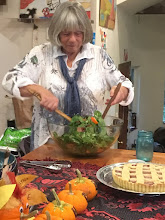When my son, Ela, was four years old, I bought him an old bicycle. It didn't have training wheels because I had the notion that he would learn better without that crutch. I taught him to ride a bicycle the way my father had taught me: by holding onto the back of the seat as he wobbled into balance. Like my father, I held onto the bicycle, then ran alongside, letting go, yelling encouragement, then, just before Ela went over, catching hold again, steadying the balance. The only places to ride a bicycle at our mountain home were rough paths and a hilly gravel driveway, but Ela took to bicycles so easily I wondered if something in a past life had prepared him.
Ela got a real bicycle, not just a learner's clunker, for his ninth birthday. By that time we were living on a different mountain, where I live still and where we had a paved road within reasonable distance. I, too, bought a bicycle that year. One day Ela and I decided to ride our bicycles the two miles up that paved road to the top of the mountain and six miles over the other side to visit his father and stepmother.
It's a steep road. I was on an old-fashioned, three-gear bicycle. Ela's bike was a BMX, without gears. Soon enough my legs gave out. My bicycle slowed to a stop, and I started walking, pushing my bike. Ela was still pedaling. The day was hot, but the road was shaded, and we had started early. Ela was strong and cocky. Walking alongside him, amused by his persistence and impressed by his stamina and strength, I said, "I bet you can't ride to the top without stopping." I didn't think he could, but I thought the challenge would be good for him. I have to admit I was that kind of parent. When Ela climbed a tree and called, "Mom! Look where I am," I would say, "Wow. That's great. Can you go any higher?" Usually he did. Now he answered my challenge without hesitation.
"I'll bet I can," he said pushing onward.
"I'll bet you a cake you can't," I said. "If you get to the top of the road without stopping, I'll make you a cake from that new recipe I just got."
At that, Ela gave a few extra hard pushes to scoot a few feet ahead of me.
The bet was on. It was slow going. I was walking and pushing my bicycle at the same rate that Ela, one hard push at a time, was riding his. Every once in a while I egged him on with a goading remark.
Ela never wavered. Steadily, slowly, with tough single-mindedness, he pushed his way two miles up the mountain without stopping. At the top, he was exultant. He let his bicycle topple and hopped off with a surprisingly energetic jig. He had won his cake.
I made the cake for him the next day. It was a good cake, made with yogurt, so it was very light. It became our favorite birthday cake. I don't know what it was originally called, but in our family it has always been known as the bicycle cake.
Next week: "A Boiled Egg in the Wilderness"
Recipe for this post: Bicycle cake
BICYCLE CAKE
10-12 servings
Ingredients
3/4 cup butter
1 cup warmed honey
3 eggs
1 1/2 teaspoon baking soda
3 cups whole wheat pastry flour
1 cup yogurt
1 teaspoon vanilla
Preparation
Butter and flour 2 8-inch layer-cake pans. Preheat the oven to 375º.
To make
Cream the butter thoroughly. Add the honey and beat till fluffy. Add the eggs one at a time, beating
well after each addition. Sift together the soda and flour and add them to the butter mixture alternately with the yogurt, beginning and ending with the dry ingredients. Mix gently Do not overmix. It's easy for this cake to lose its fluff. Fold the vanilla carefully into the batter. Pour the batter into the prepared cake pans and bake at 375º until a toothpick inserted in the center comes out clean, 15-20 minutes. Cool five minutes and invert. Ice as you wish.























